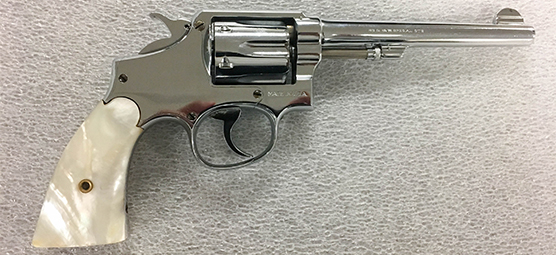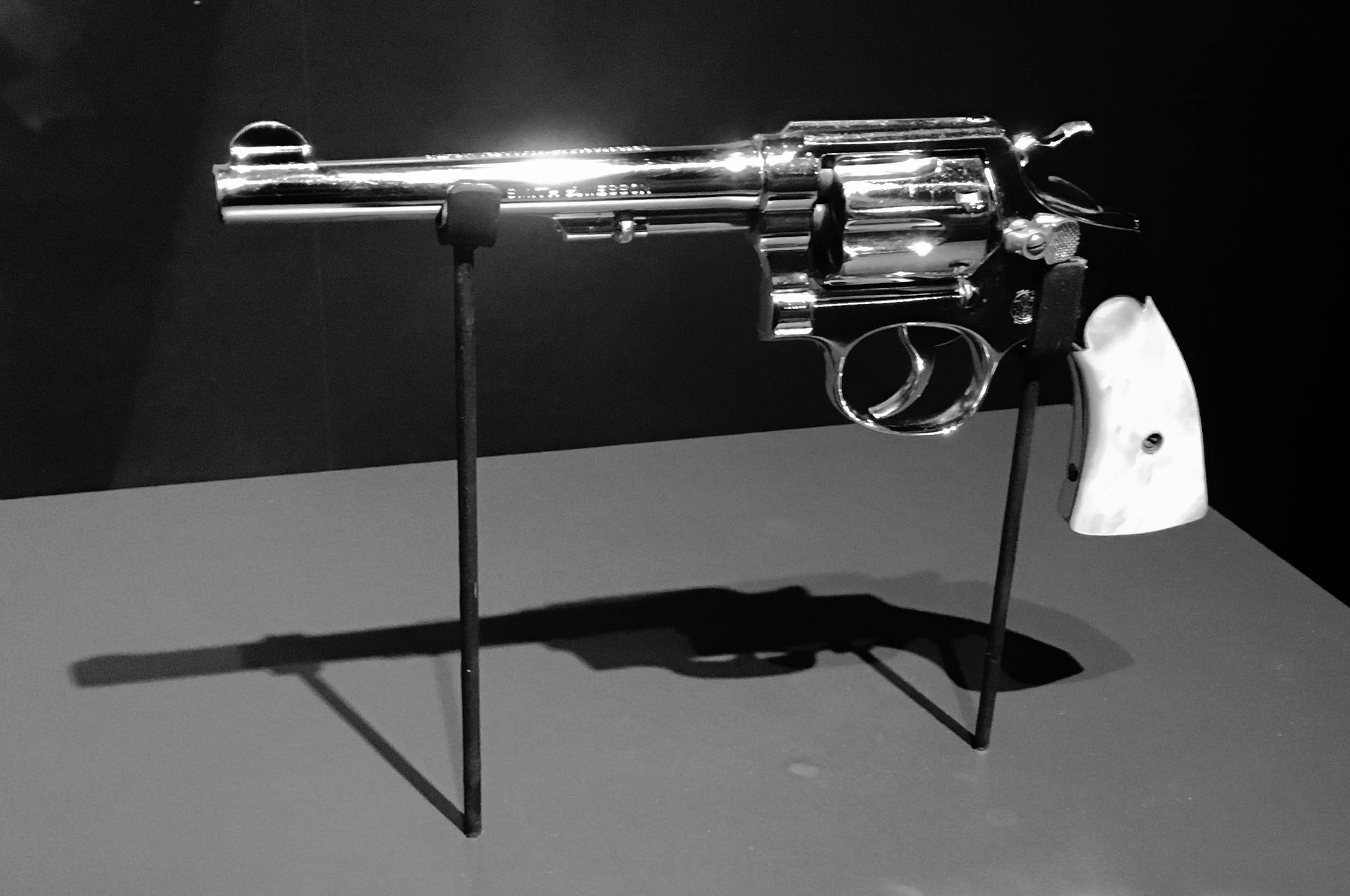Al Capone gun on display at Mob Museum
Revolver seized from Chicago crime boss in Miami on loan from IRS Criminal Investigation Division

A .38-caliber revolver believed to have been seized from Al Capone during a 1928 arrest in Miami is now on display at The Mob Museum.
The IRS Criminal Investigation Division has loaned the Smith & Wesson .38 to the Museum. IRS agents confiscated the firearm during a 2004 raid of an illegal gambling den in Kentucky.
 The gun is on display near an exhibit dedicated to the Treasury Department’s Special Intelligence Unit, known as the “T-Men.” Agents of the unit famously investigated gangsters and bootleggers from the 1920s through the 1940s. After a three-year undercover investigation in the late ’20s, the T-Men succeeded in building a tax evasion case against Capone, who was convicted and sentenced to 11 years in prison in 1931. The Special Intelligence Unit was renamed Criminal Investigation (CI) in 1978.
The gun is on display near an exhibit dedicated to the Treasury Department’s Special Intelligence Unit, known as the “T-Men.” Agents of the unit famously investigated gangsters and bootleggers from the 1920s through the 1940s. After a three-year undercover investigation in the late ’20s, the T-Men succeeded in building a tax evasion case against Capone, who was convicted and sentenced to 11 years in prison in 1931. The Special Intelligence Unit was renamed Criminal Investigation (CI) in 1978.
On Tuesday, September 27, Jonathan Ullman, executive director and chief executive officer of The Mob Museum, and Richard Weber, chief of the Criminal Investigation Division, unveiled the display case containing Capone’s gun on the Museum’s third floor. The gun will remain on display at the Museum until the spring of 2018.
“We all know very well that these T-Men were the ones most instrumental in bringing down the titans of organized crime back in the Prohibition and post-Prohibition eras,” Ullman said at the unveiling.
“I have to say that we have benefited a great deal through our interactions with IRS CI,” Ullman said. “They’ve enabled us to better understand the history and accurately tell the stories of the past, and those who have studied the subject matter know there is an awful lot of mythology that surrounds figures like Al Capone. The IRS CI has helped us to describe the history as it actually happened.
“Beyond that, we share a tremendous gratitude for this agency that every day is out there catching criminals, reclaiming funds that rightfully belong to the American people, literally tens of billions of dollars each year, and they do that despite staffing levels that have not been lower since the mid-1970s. And still this is the agency that continues to persevere in serving the public.”
The Criminal Investigation Division has a worldwide staff of agents who investigate financial crimes involving tax and money laundering and public corruption, cybercrime, identity theft and narcotics and terrorist financing. Chief Weber outlined some of the agency’s history.
“IRS CI has a rich history, and it’s wonderful to celebrate that history as we near our 100th anniversary as a law enforcement agency,” he said. “Yet many people around the world do not fully understand or know about CI’s involvement in some of this country’s biggest financial crime cases, corruption cases, terrorism and money laundering cases. Our very first chief of CI, it was known as the Intelligence Unit back then, his name was Elmer Irey, and he took the reins of the organization as gangsters spread corruption to every major city within the U.S. The most famous gangster of them all was Al Capone. Try as they might, law enforcement and prosecutors could not bring Capone to justice. President Herbert Hoover asked Chief Irey to personally get involved and for the agency to get involved.
“Frank Wilson, who was the determined case agent, and Mike Malone, who was the IRS undercover agent who lived among Al Capone and his men for three years, collecting and transmitting valuable information about the gangster and his activities – these are the unsung heroes of this organization. In October of 1931, almost 85 years ago to this day, Al Capone was convicted of tax evasion, and the wave of corruption that swept across the United States began turning in the other direction.”
The .38 revolver was manufactured by Smith & Wesson in 1925. It was shipped from the factory and sold by Wolf & Klar Company, a gun dealer in Fort Worth, Texas. Wolf & Klar was known for installing pearl grips on the revolvers it sold.
Capone, the boss of the Chicago Outfit, obtained the gun in 1928 while he was living part time in a palatial estate in Miami Beach. While there, Capone decided he needed some extra firepower for protection. He had a friend, hotel manager Parker Henderson Jr., purchase six revolvers and six shotguns from a Miami pawn shop, which had procured them from Wolf & Klar.
Later that year, one of the shotguns and two of the revolvers were recovered from an abandoned car believed to have been used by the gunmen responsible for the murder of Brooklyn crime kingpin Frankie Yale, Capone’s former employer. Historians have long suspected that Capone orchestrated Yale’s murder.
Capone was arrested in Miami that year on a minor charge. While searching his house, police confiscated the pearl-handled .38 revolver that was among those Henderson had purchased for him.
The revolver would change hands several times over the ensuing decades. A police captain involved in Capone’s arrest sometime later gave the pistol to a tour bus operator named James Campbell. Campbell had been paying the captain in order to park his tour bus in prime locations, and the captain gave him the gun as a gift.
Campbell later moved to Grosse Point Park, Michigan, where he rented out apartments, including one to a man named Warren Hogancamp starting in 1954. Hogancamp did odd jobs for Campbell and became like a son to him. Around 1959 Campbell gave the gun to Hogancamp as a gift and told him the story of how he had received it.
Hogancamp moved to Kentucky in 1965. He sold the gun in 2003 to a man named Billy Clayton, who operated an illegal gambling business in Mayfield, Kentucky. IRS Criminal Investigation agents raided Clayton’s operation in 2004 and seized the gun.
IRS CI – the same federal law enforcement agency responsible for busting Capone for tax evasion – has had the revolver ever since.
Feedback or questions? Email blog@themobmuseum.org





